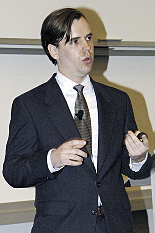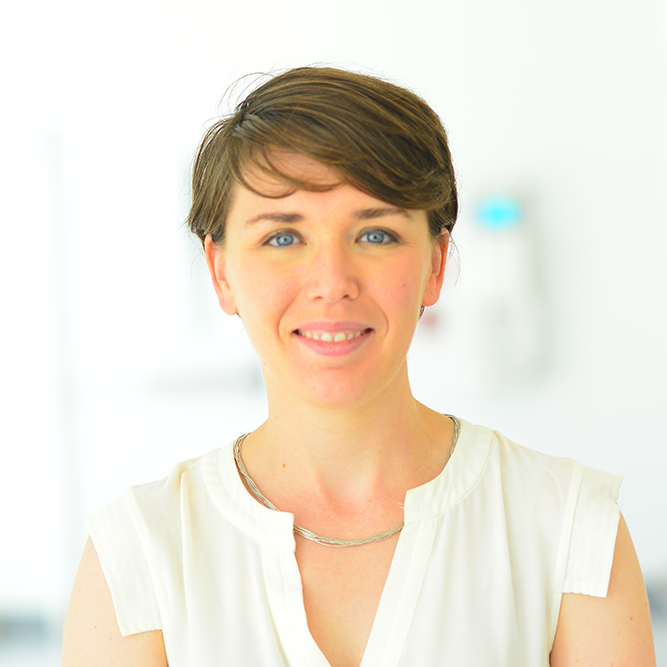News Story
UM $50K Business Plan Competition Winners Announced

MTECH Ventures, an initiative of the A. James Clark School of Engineering, announces the winners of the 2007 University of Maryland $50K Business Plan Competition.
Winners were chosen among nine finalist teams in three categories during an event on April 27. Each team gave investor presentations to a team of distinguished judges. Every team won prize money.
Faculty and Graduate Student Division
-
Accelign, a biomedical company developing a hardware accelerator that quickly fuses or “registers” medical images from multiple sources to accurately create a single three-dimensional image, took first place, winning $10,000. “The competition offered valuable mentorship and advising for our business,” said Accelign CEO Dr. William Plishker, a research associate at the University of Maryland. “We plan to leverage the competition to launch our product.” Accelign team members also include CTO Professor Raj Shekhar and electrical and computer engineering graduate students Omkar Dandekar and Yashwanth Hemaraj.
-
Remedium Technologies Inc., a company developing nanotechnology-based active wound care products, took second place, winning $8,000. Remedium team members include: Bani H. Cipriano, chemical and biomolecular engineering graduate student; Peter Thomas, bioengineering graduate student; Mattew Dowling, bioengineering graduate student; Oluwatosin Ogunsola, chemical and biomolecular engineering research associate; Chao Zhu, chemical and biomolecular engineering research associate; and Srinivasa Raghavan, assistant professor, Dept. of Chemical & Biomolecular Engineering, and Akinola Dosunmu, CFA, CPA.
-
BioFactura Inc, a biopharmaceutical development company focused on solving unmet medical and national security needs in the infectious disease arena, tied for third place, winning $2,500. BioFactura team members include: Darryl Sampey, bioengineering graduate student (May '10), and Alex Matschiner; and Luis Branco.
-
SD Nanosciences, a spin-off of the University of Maryland with a proprietary “Triad” technology that has applications in vaccines, cancer diagnostics, and specialty research probes, tied for third place, winning $2,500. SD Nanosciences team members include: Philip DeShong professor of chemistry and biochemistry; Daniel Stein, professor of cell biology and molecular genetics; Terry Chase Hazell.
Young Alumni Division
-
Aid Networks, a seed stage medical device company developing small, portable, wireless, wearable vital sign monitors, took first place, winning $10,000. Aid Networks team members include a computer engineering and Hinman CEOs alumna; David Crawford, a computer engineering major and Hinman CEOs student; and Leo Selavo, a research associate at the University of Virginia.
-
Geo-Haul LLC, a company developing Space-Tug, a robotic tow designed to dispose of aging satellites, took second place, winning $8,000.Geo-Haul team members include: Andrew Long, aerospace engineering alumnus ('03); Brian Roberts, aerospace engineering alumnus (1999); fire protection engineering graduate student ('08); Dr. Dave Akin, aerospace engineering associate professor and director, University of Maryland Space Systems Laboratory and NASA Institute for Dexterous Space Robotics.
-
Erudition, a company developing online learning communities, took third place, winning $2,000. Erudition team members include: Brian Guenther, 2006 alumnus of the University of Maryland; Kurt Mansperger, computer engineering and finance undergraduate student; Jon Krangel, Hinman CEOs and finance undergraduate student
Undergraduate Division
-
IMPACT Education LLC, a company that develops low-cost educational kits that university professors can use to teach MEMS fabrication outside of expensive laboratory facilities, took first place, winning $5,000. IMPACT’s team, all undergraduate Gemstone students unless otherwise noted, includes: Kristin Freese, English and government and politics major; electrical engineering major Ryan Herrera; mechanical engineering major Steven Hoffenson; criminology and criminal justice alumna Kate Imp; marketing and logistics major Paul Kang; Hinman CEOs and computer engineering major John Karvounis; finance and accounting major Jamie Kim; Hinman CEOs, computer science and math major Wei-Liang William Lai; Hinman CEOs, computer engineering and finance major Peter Orlicki; economics major Fred Perrotta; mechanical engineering major Jennifer Thompson; psychology major Joe Wakeman-Linn; information systems and finance major Ben Worku; and electrical engineering major Travis Young.
-
Medical Error Reduction through Information Technology (MERIT), a company developing Meritrack, a low-cost, scalable, and flexible total procedural healthcare systems solution that will reduce human error in healthcare and support efficiency in clinical record keeping, took second place, winning $2,000. MERIT team members include (all undergraduate students except where noted): James Briscoe, Gemstone and aerospace engineering ('08); Michael Cortina, Hinman CEOs, Gemstone, and mechanical engineering ('08); John Gianfrancesco, Hinman CEOs and Finnace ('08); Timothy Han, Gemstone, electrical engineering, ('08); Dennis Kim, Gemstone, electrical engineering ('08); Joshua Macht, Gemstone, cell biology and molecular genetics ('08); Michael Maraña, Gemstone, aerospace engineering ('08); Michael McKay, Gemstone, government and politics, mathematics, and computer science ('08); Gregory Parkins, Gemstone, Finance, economics, and government and politics ('07); Vasanthi Raghavan, Gemstone, mechanical engineering ('08); Andreas Saltos, Gemstone, biomedical engineering ('08); Theodore Tien, Gemstone, finance, and marketing, ('08); Michael Vellucci, Hinman CEOs, accounting, and finance ('08); Kyle Weber, Gemstone, electrical engineering ('08); Victoria Yan, Hinman CEOs, Gemstone, and electrical engineering ('08); Dr. Gilmer Blankenship, professor and associate chair for external affairs, electrical engineering and Chairman, TechnoSci, Inc.
Finalists were selected from 18 semifinalists, and nearly 60 initial entries.
Judges for the event were: Jonathan Aberman, Founder and Managing Director, Amplifier Venture Partners; Henry Ahn, Program Manager, Technology Funding Programs, Maryland Technology Development Corporation (TEDCO); Warren Citrin, CEO, Gloto; Ray Dizon, Managing Director, Maryland Venture Fund; Mark Kass, Member, Mintz, Levin, Cohn, Ferris, Glovsky and Popeo; Karl Renner, Principal, Fish & Richardson P.C.
Sponsors for the competition included Fish & Richardson P.C.; Mintz, Levin, Cohn, Ferris, Glovsky and Popeo; Maryland Department of Business and Economic Development; Maryland Technology Development Corporation.
The competition, now in its seventh year, has historically awarded a total of $385,000 in prizes to faculty, students and alumni with the best plans for innovative ventures. Previous winners include Chesapeake Perl, AnthroTronix, Squarespace, Affiliate Classroom, and RioRey (previously known as Macrophage).
For a complete list of winners, and more photos, please visit the UM $50K Business Plan Competition Web site, at http://www.bpc.umd.edu.
About MTECH Ventures (www.mtechventures.umd.edu)
MTECH Ventures, an initiative of the Maryland Technology Enterprise Institute in the A. James Clark School of Engineering, provides cutting-edge entrepreneurship education to technology creators and stimulates venture creation by delivering a portfolio of services and resources to entrepreneurs committed to bridging the gap between technical ideas and viable ventures.
Published April 30, 2007









